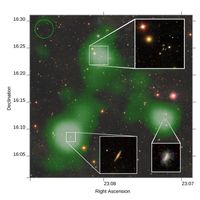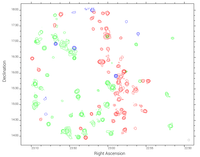Tidal Encounters
While ram pressure stripping is likely the dominant gas-loss mechanism at work in giant clusters, elsewhere galaxies can be more affected by gravitational encounters with other galaxies. This can happen in clusters as well, but there the galaxies are moving so quickly that they have only the briefest of brief encounters : too quick for any real damage to be done. Outside clusters, however, it's a different story.
A spectacular example of a probable tidal stream can be found in the NGC 7448 galaxy group :
In the little trio of galaxies on the left, you can clearly see that their stars have been disturbed. That indicates the interaction is particularly strong, since the stars are generally more compact and harder to perturb than the gas. In most cases the gas is a better way of looking for disturbances because it doesn't take such a violent encounter to remove it. In fact, radio observations reveal that the gas connects the galaxies spanning the entire image – information we could never get from the optical data alone.
My PhD supervisor published a quick study of the NGC 7448 field, but later I realised there was a lot of interesting stuff going on behind the target group as well. This was a rich field with hundreds of HI (atomic hydrogen) detections, some of which were in close proximity to each other. At first glance there were no obvious signs of any interactions, but in some cases integrated flux maps revealed long streams and bridges of HI – some of which are very long indeed, as much as 800 kpc in extent !
In this analysis we did a lot of cleaning of the data to ensure our measurements were as accurate as possible. For example, when we suspected we'd found a bridge between two galaxies, we'd make a model of the flux in the galaxies and subtract this to make an image of only the gas in the bridge (a residual image). This works well in cases like this, where the galaxies are unresolved and easy to model while the streams are extended – it's much harder to do this in Virgo, where we used different techniques to uncover much shorter streams.
Most of the streams here aren't visible except by making integrated flux maps, summing the flux over all the frequency channels in which a source is present. And even then, most galaxies – especially the isolated ones – don't show any hint of emission. But many do. We were also able to show that the streams were most common among galaxies at similar velocities to one another, meaning they would have had the slow, prolonged interactions favourable for removing gas by gravitational interactions.
There is an alternative explanation for streams like this : accretion. Primordial gas might be slowly cooling along large-scale cosmic filaments, condensing down into individual galaxies. This is certainly a possibility. But most of the spectacular HI features are associated with similarly impressive disturbances in the stellar components of the galaxies – not only the NGC 7448 group itself, but also things like UGC 12342, which is embedded in a ~450 kpc envelope of gas. While we can't rule out accretion, there's also no clear reason to favour it over tidal interactions.
Because of the superlatively long nature of the streams, we did a press release you can read here. And because of the agony of the review process, you can read my much more cynical version here.


